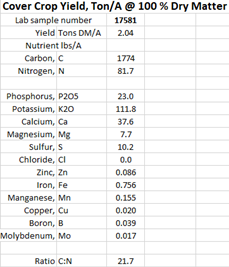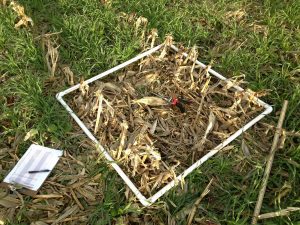If you are committed to quantifying how your cover crop performed, taking biomass samples is a critical next level step. This takes your visual observations or feelings and puts some numbers behind it. Before you take these samples, determine what you want to learn from your test. There are essentially two choices.

A sample lab analysis table
The first option is Cover Crop Nutrient Density. This is used mostly to determine how effective your cover was at capturing, producing or making nutrients available in the soil. Just like the laws of energy, nutrients are not created or destroyed, but rather transferred. What are you doing to make your nutrients available to your next crop?
The carbon and nitrogen, displayed along with the calculated ratio to help display how readily your plant residue will cycle back into the soil. As well as your micro and macro nutrients, this test also displays what your cover was effectively able to render available from your soil. I bet that you can compare this to your soil test and you will notice some eye-opening differences.
Please note that the nutrients you see from this test are what are in the above-ground biomass. Don’t forget that we have a whole network of nutrients still in the soil. How many nutrients the root structure has will vary, but we have seen research suggesting another 20-30% nutrients. Note that if your plant reaches a reproductive growth stage, it is in the process of translocating much of its nutrient density and seed production.
The second option is a Forage Quality Analysis. This test will cover all aspects commonly viewed for forage quality indicators. Your animal species, sex, growth stage, body condition, reproductive stage, etc. will all play into what an ideal forage would look like. Rather than explaining all these, here are some sources to study up on what your ideal results may be.
- Understanding Feed Analysis – University of Nebraska-Lincoln
- Interpreting Forage Quality Reports – University of Kentucky
- Determining Forage Quality – Penn State University
- Nutrient Requirements of Beef Cattle – Oklahoma State University
As a reference, I have attached an example of what a forage analysis from Ward Labs would look.
Now it’s time to take your biomass sample. The procedure is the same no matter which test fulfills your needs.
- Site Selection – Select an area that’s an average representation of your mixture. Once the general area is selected, pitch an object randomly at least 10’ in any direction. That object marks the middle of your sampling location. This step will help take bias out of your sampling site.
- Define Sample Location – Measure a 3’x3’ square, with the thrown object as the center point. This will define the sample area and help us determine DM production per acre.
- Collect Forage Sample – Now use your clippers or knife to collect all above-ground biomass production desired. Depending on your management goals for the end use of your cover, you could collect the biomass at variable heights. Collect only your cover crop’s above-ground biomass to determine what was produced. If grazing or haying, we can estimate how effective you’ll be at utilizing that biomass based on your management goals. If you’re haying or chopping, collect all biomass above cutter bar height. Fill your paper bag with the sample (paper allows the sample to breathe and slows the degradation of the sample as opposed to a plastic bag).
- Sample Handling – Now the collected sample can be processed. You can immediately ship the sample to the lab only if it can be mailed and processed before the end of the work week. Otherwise, we suggest you take the sample to a stable location out of the elements, where it won’t get contaminated, allowing it to air dry for a few days. This will greatly reduce the moisture content of the sample, helping preserve the biomass and reduce shipping costs.
- Specify Sample Information – It’s important when sending a sample to a lab that you print their sample submission form or at least give all your contact and billing information. You can utilize the submission sheet below if you’re sending the sample to Ward Labs. Otherwise, on your sample specify that you want to determine…
- Total DM weight of the ENTIRE sample in pounds! Specify that the sample was taken from a 3’x3’ square and you would like to know total pounds per acre.
- 43,560 ft2 = acre: Simply take 4840 X #/DM(from your sample) = your DM #/A
- Plus what other tests you desire to run. RFG test for forage purposes or routine plant analysis for a standard cover crop
- Total DM weight of the ENTIRE sample in pounds! Specify that the sample was taken from a 3’x3’ square and you would like to know total pounds per acre.
 If you would like to print the sampling procedures, you can download them below.
If you would like to print the sampling procedures, you can download them below.
At Home Dry Matter Calculations
DM is easy to calculate at your home by following these simple steps.
Resources needed:
- Microwave with a turntable (That you hate and not located in your house)
- Microwave safe plastic or glass plate
- Scale that can calculate g
- Glass of water to prevent combustion of dry forages
Procedure:
- Document the weight of your empty plate.
- Document total biomass sample weight in lbs for easiest calculations.
- Use g or oz if you want to be more accurate
- Collect a uniform sub sample of your plant tissue. 227 grams is about ½ a pound.
- For the most uniform sub sample, it would be best to chop up the biomass you collected into manageable sized pieces and blend
- Put your tissue sample on the plate and place in the microwave with glass ½ full of water.
- Run the microwave for 4 minutes on high.
- Take sample and plate from the microwave add record the total weight.
- Put plate back in the microwave and run on high for 2 minutes.
- Be sure your glass of water never gets below ½ full before starting the next bake cycle
- Repeat step 5 and 6 until the plate and sample weight long longer changes (+/- 1 gram)
- This means your sample has 0% moisture and completely dry.
- Subtract your plate weight from your plate/biomass weight.
- This tells you what your biomass samples weighs
Mathematics Example:
- Plate alone weighs 300 g
- Plate + biomass weighs 527 g
- Plate + completely dry sample (no longer lose weight) weighs 400 g
- Final Math for % DM
- 400 g (plate & dry biomass) – 300 g (plate) = 100 g
- 100 g (dry sample) / 227 g (initial sample) = .44 x 100= 44% Dry Matter
- Take your whole sample weight from step 2 in procedures and multiple it by .44.
- Gives dry matter production for your sampled area
- Multiply your sampled area to the per acre amount
- Ex. You had 5# from a 3’x3’ area and it was determined to be 44% DM.
- 5# x .44= 2.2# DM for your 9 sqft
- 43.560 sqft in an acre
- 2.2#/9sqft x 43,560sqft=10,648#/A of DM production
- 5# x .44= 2.2# DM for your 9 sqft
- Ex. You had 5# from a 3’x3’ area and it was determined to be 44% DM.
